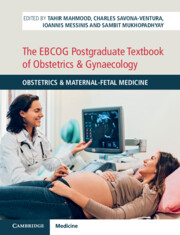Book contents
- The EBCOG Postgraduate Textbook of Obstetrics & Gynaecology
- The EBCOG Postgraduate Textbook of Obstetrics & Gynaecology
- Copyright page
- Dedication
- Contents
- Contributors
- Preface
- Section 1 Basic Sciences in Obstetrics
- Section 2 Early Pregnancy Problems
- Chapter 6 Bleeding in Early Pregnancy
- Chapter 7 Acute Abdomen in Early Pregnancy
- Chapter 8 Gestational Trophoblastic Disease
- Chapter 9 Hyperemesis Gravidarum
- Section 3 Fetal Medicine
- Section 4 Maternal Medicine
- Section 5 Intrapartum Care
- Section 6 Neonatal Problems
- Section 7 Placenta
- Section 8 Public Health Issues in Obstetrics
- Section 9 Co-Morbidities during Pregnancy
- Index
- Plate Section (PDF Only)
- References
Chapter 7 - Acute Abdomen in Early Pregnancy
from Section 2 - Early Pregnancy Problems
Published online by Cambridge University Press: 20 November 2021
- The EBCOG Postgraduate Textbook of Obstetrics & Gynaecology
- The EBCOG Postgraduate Textbook of Obstetrics & Gynaecology
- Copyright page
- Dedication
- Contents
- Contributors
- Preface
- Section 1 Basic Sciences in Obstetrics
- Section 2 Early Pregnancy Problems
- Chapter 6 Bleeding in Early Pregnancy
- Chapter 7 Acute Abdomen in Early Pregnancy
- Chapter 8 Gestational Trophoblastic Disease
- Chapter 9 Hyperemesis Gravidarum
- Section 3 Fetal Medicine
- Section 4 Maternal Medicine
- Section 5 Intrapartum Care
- Section 6 Neonatal Problems
- Section 7 Placenta
- Section 8 Public Health Issues in Obstetrics
- Section 9 Co-Morbidities during Pregnancy
- Index
- Plate Section (PDF Only)
- References
Summary
Acute abdomen describes severe abdominal pain usually of less than 24 hours’ duration that may require emergency surgery. This is a very common presentation in the gynaecology services. In the pregnant patient the underlying cause may be pregnancy related or non-pregnancy related. Assessment and diagnosis are often challenging due to the influence of pregnancy on maternal physiology and the very wide range of differential diagnoses [1]. Abdominal pain is a very common symptom in pregnancy that most often resolves without much intervention. This observation may make the clinician complacent and therefore less suspicious of more serious or life-threatening underlying pathology. Diagnostic evaluation is further complicated by altered reference ranges of laboratory tests. A multidisciplinary team approach is essential to facilitate an efficient diagnostic workup as well as ensuring the most effective treatment is initiated without undue delay.
- Type
- Chapter
- Information
- The EBCOG Postgraduate Textbook of Obstetrics & GynaecologyObstetrics & Maternal-Fetal Medicine, pp. 55 - 63Publisher: Cambridge University PressPrint publication year: 2021

